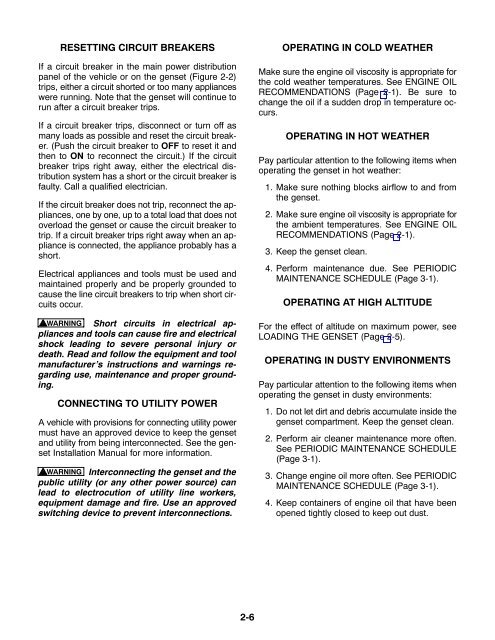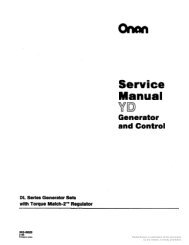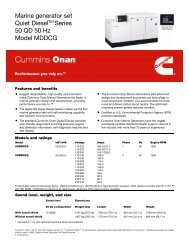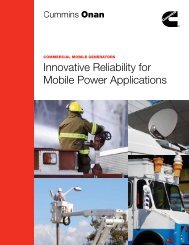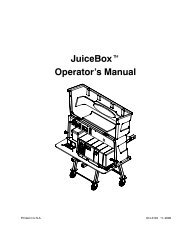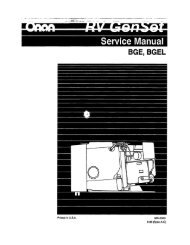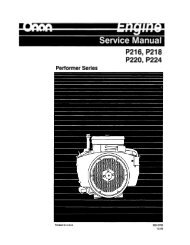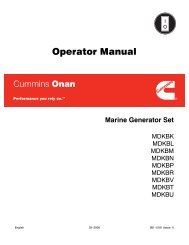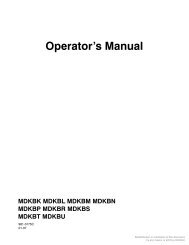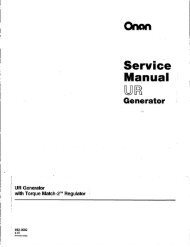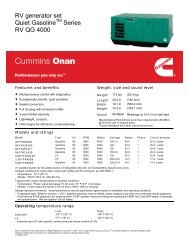Caution: This document contains mixed page sizes ... - Cummins Onan
Caution: This document contains mixed page sizes ... - Cummins Onan
Caution: This document contains mixed page sizes ... - Cummins Onan
Create successful ePaper yourself
Turn your PDF publications into a flip-book with our unique Google optimized e-Paper software.
RESETTING CIRCUIT BREAKERS<br />
If a circuit breaker in the main power distribution<br />
panel of the vehicle or on the genset (Figure 2-2)<br />
trips, either a circuit shorted or too many appliances<br />
were running. Note that the genset will continue to<br />
run after a circuit breaker trips.<br />
If a circuit breaker trips, disconnect or turn off as<br />
many loads as possible and reset the circuit breaker.<br />
(Push the circuit breaker to OFF to reset it and<br />
then to ON to reconnect the circuit.) If the circuit<br />
breaker trips right away, either the electrical distribution<br />
system has a short or the circuit breaker is<br />
faulty. Call a qualified electrician.<br />
If the circuit breaker does not trip, reconnect the appliances,<br />
one by one, up to a total load that does not<br />
overload the genset or cause the circuit breaker to<br />
trip. If a circuit breaker trips right away when an appliance<br />
is connected, the appliance probably has a<br />
short.<br />
Electrical appliances and tools must be used and<br />
maintained properly and be properly grounded to<br />
cause the line circuit breakers to trip when short circuits<br />
occur.<br />
WARNING Short circuits in electrical appliances<br />
and tools can cause fire and electrical<br />
shock leading to severe personal injury or<br />
death. Read and follow the equipment and tool<br />
manufacturer’s instructions and warnings regarding<br />
use, maintenance and proper grounding.<br />
CONNECTING TO UTILITY POWER<br />
A vehicle with provisions for connecting utility power<br />
must have an approved device to keep the genset<br />
and utility from being interconnected. See the genset<br />
Installation Manual for more information.<br />
WARNING Interconnecting the genset and the<br />
public utility (or any other power source) can<br />
lead to electrocution of utility line workers,<br />
equipment damage and fire. Use an approved<br />
switching device to prevent interconnections.<br />
OPERATING IN COLD WEATHER<br />
Make sure the engine oil viscosity is appropriate for<br />
the cold weather temperatures. See ENGINE OIL<br />
RECOMMENDATIONS (Page 2-1). Be sure to<br />
change the oil if a sudden drop in temperature occurs.<br />
OPERATING IN HOT WEATHER<br />
Pay particular attention to the following items when<br />
operating the genset in hot weather:<br />
1. Make sure nothing blocks airflow to and from<br />
the genset.<br />
2. Make sure engine oil viscosity is appropriate for<br />
the ambient temperatures. See ENGINE OIL<br />
RECOMMENDATIONS (Page 2-1).<br />
3. Keep the genset clean.<br />
4. Perform maintenance due. See PERIODIC<br />
MAINTENANCE SCHEDULE (Page 3-1).<br />
OPERATING AT HIGH ALTITUDE<br />
For the effect of altitude on maximum power, see<br />
LOADING THE GENSET (Page 2-5).<br />
OPERATING IN DUSTY ENVIRONMENTS<br />
Pay particular attention to the following items when<br />
operating the genset in dusty environments:<br />
1. Do not let dirt and debris accumulate inside the<br />
genset compartment. Keep the genset clean.<br />
2. Perform air cleaner maintenance more often.<br />
See PERIODIC MAINTENANCE SCHEDULE<br />
(Page 3-1).<br />
3. Change engine oil more often. See PERIODIC<br />
MAINTENANCE SCHEDULE (Page 3-1).<br />
4. Keep containers of engine oil that have been<br />
opened tightly closed to keep out dust.<br />
2-6


